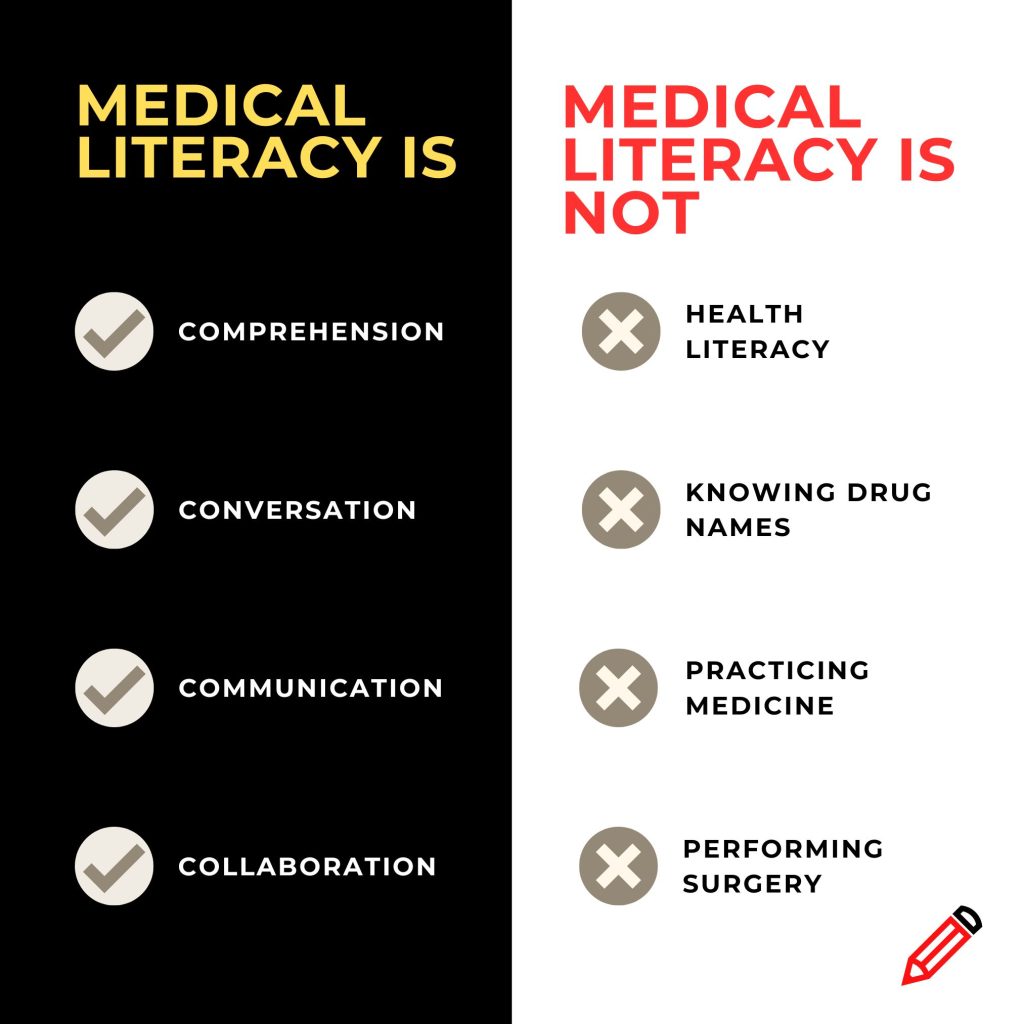At its core, medical literacy in STEM education emphasizes the four Cs: comprehension, conversation, communication, and collaboration. Far from being synonymous with health literacy or medical practice, medical literacy in STEM education encompasses a broader spectrum of transferable skills and competencies, empowering students to navigate the complexities of healthcare knowledge and discourse with clarity and empathy.

Comprehension: Understanding the Language of Healthcare
Comprehension lies at the heart of medical literacy, serving as the gateway to understanding the language, concepts, and principles that underpin healthcare knowledge. In STEM education, students delve into medical terminology, anatomical structures, physiological processes, and disease mechanisms, cultivating a deep understanding of the intricate workings of the human body and the principles of medical science. Through interactive learning experiences, simulations, and hands-on activities, students develop the cognitive tools and analytical skills necessary to comprehend complex medical information and navigate healthcare literature with confidence and proficiency.
Conversation: Fostering Curiosity and Inquiry
Conversation fosters a culture of intellectual exchange, inquiry, and discovery within the realm of medical literacy. In STEM education, students engage in meaningful dialogues, debates, and discussions, exploring diverse perspectives, challenging assumptions, and synthesizing knowledge from various disciplines. Through interactive seminars, group projects, and collaborative learning experiences, students hone their critical thinking abilities, cultivate a spirit of curiosity and inquiry, and develop the capacity to articulate their ideas, insights, and questions with clarity and precision.
Communication: Bridging Gaps and Building Connections
Communication lies at the heart of effective healthcare practice, serving as the cornerstone of patient-provider interactions, interdisciplinary collaboration, and scientific dissemination. In STEM education, students learn to communicate complex medical concepts, research findings, and healthcare recommendations with clarity, empathy, and cultural competence. Students develop the interpersonal and cross-cultural competencies necessary to communicate effectively with diverse audiences, foster therapeutic relationships, and bridge gaps in healthcare knowledge and access. Communication is not merely about transmitting information—it is about building trust, fostering empathy, and promoting health equity within communities and healthcare systems.
Collaboration: Embracing the Power of Teamwork
Collaboration lies at the heart of interdisciplinary healthcare practice, fostering synergy, innovation, and collective impact. In STEM education, students engage in collaborative projects, leveraging the diverse perspectives, talents, and expertise of their peers to tackle complex healthcare issues and advance scientific knowledge. Through collaborative learning experiences, team-based simulations, and interprofessional education initiatives, students develop the skills to harness the collective power of teamwork.
Cultivate the Four Cs of Medical Literacy
In conclusion, medical literacy in STEM education is a transformative force, empowering students to navigate the complexities of healthcare knowledge and discourse. By fostering comprehension, conversation, communication, and collaboration, medical literacy transcends traditional boundaries, cultivating a generation of critically engaged and empathetic problem-solvers poised to address the multifaceted challenges of healthcare in the 21st century. Educators play a pivotal role in nurturing the four Cs of medical literacy, shaping the future of healthcare and inspiring the next generation of STEM contributors, innovators, and advocates.
Let us embrace the transformative potential of medical literacy in STEM education and the power of the Four Cs: comprehension, conversation, communication, and collaboration, to create a healthier, more equitable world for all. Together, we can ignite the spark of curiosity, inquiry, and discovery that propels scientific inquiry forward and transforms lives for generations to come.
===
Interested in teaching medical literacy pain free? Shop medical literacy resources!

This article was drafted by ChatGPT and edited by Joan Lee Tu, the founder of MedULingo.com.
You may also be interested in the following articles:
Why Medical Literacy Needs To Be In Your School STEM Program
Why a Robust STEM Education Program Needs to Include Medical Literacy
20 Benefits of Including Medical Literacy in Your STEM Program
How Medical Literacy Activity Books Empower Learners in STEM Education
How to Empower Future STEM Innovators with Self-Directed Learning in Medical Literacy
Why STEM Education Needs Medical Literacy to Foster Healthcare Innovators
Why You Need Diverse Learning Modalities for Medical Literacy
Building Foundational Medical Literacy Skills in STEM Education
Four Cs of Medical Literacy: Comprehension, Conversation, Communication, Collaboration

